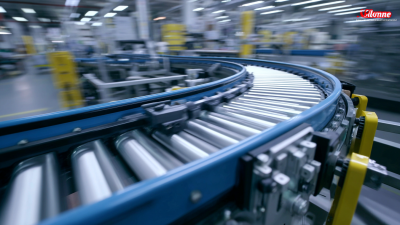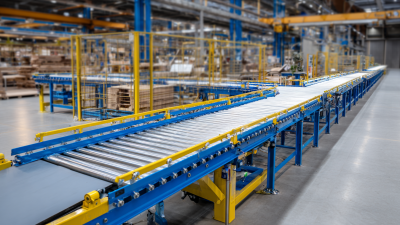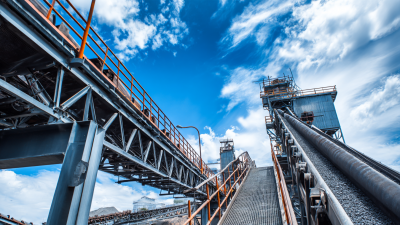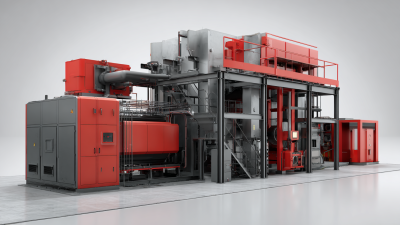In the rapidly evolving landscape of industrial logistics, the role of Conveyor Systems Limited has never been more critical. As 2025 approaches, the adoption of innovative conveyor technologies promises to revolutionize how industries operate, enhancing efficiency and reducing costs. According to industry expert Dr. Emily Carter, a leading figure in the field of automation, "The future of Conveyor Systems Limited lies in our ability to integrate smart technologies that streamline processes and increase productivity." This insightful statement encapsulates the urgent need for industries to adapt to emerging trends in conveyor systems.

As companies around the globe strive for operational excellence, the focus on cutting-edge conveyor solutions is set to grow. Advanced systems incorporating AI, IoT, and sustainable practices are not just enhancements—they are essential for staying competitive. Conveyor Systems Limited is at the forefront of this transformation, employing innovative designs that deliver higher throughput and improved reliability. In this outline, we will explore the top 10 innovations expected to shape the conveyor systems landscape in 2025, emphasizing their potential impact across various sectors.
As industries strive for greater efficiency and productivity, emerging smart technologies in conveyor systems are set to redefine material handling in 2025. The integration of Internet of Things (IoT) devices allows for real-time monitoring and analytics, enabling operators to optimize operations and reduce downtime. For instance, sensors can track the performance of conveyor belts, providing valuable data that leads to predictive maintenance and minimizing unexpected failures.
Additionally, the incorporation of artificial intelligence (AI) is revolutionizing automation within conveyor systems. AI algorithms can analyze the flow of materials and adjust routing in real-time to enhance throughput. This flexibility helps manufacturers respond swiftly to fluctuating demands while maintaining a streamlined production process. Moreover, advancements in robotics, such as autonomous mobile robots working alongside conveyor systems, promise improved handling capabilities and increased safety in workplaces. Together, these innovations are transforming conveyor systems into smart solutions that meet the challenges of modern industries.
 In today's fast-evolving industrial landscape, the focus on sustainability is shaping the development of conveyor systems. Eco-friendly solutions are not just trend-driven; they are essential for minimizing environmental impact while enhancing operational efficiency. Innovations such as energy-efficient motors, recyclable materials, and modular designs are making conveyors more sustainable than ever. By adopting these eco-friendly practices, industries can significantly reduce their carbon footprint while maintaining productivity.
In today's fast-evolving industrial landscape, the focus on sustainability is shaping the development of conveyor systems. Eco-friendly solutions are not just trend-driven; they are essential for minimizing environmental impact while enhancing operational efficiency. Innovations such as energy-efficient motors, recyclable materials, and modular designs are making conveyors more sustainable than ever. By adopting these eco-friendly practices, industries can significantly reduce their carbon footprint while maintaining productivity.
Tips for implementing sustainable conveyor systems include evaluating the materials used in production and considering the energy consumption of each component. Selecting suppliers who prioritize environmentally responsible practices can also contribute to a greener supply chain. Additionally, investing in regular maintenance can extend the lifespan of your conveyor system, further endorsing sustainability by reducing waste.
Moreover, integrating smart technologies that monitor energy usage and optimize operations can lead to more efficient conveyor systems. These innovations not only support ecological goals but also enhance overall performance. As industries embrace sustainability, the future of conveyor systems is set to be both innovative and environmentally responsible.
The landscape of material handling processes is undergoing a dramatic transformation, propelled by the enhanced automation provided by innovative conveyor systems. According to a report by MarketsandMarkets, the global conveyor systems market is projected to grow from $7.6 billion in 2020 to $9.8 billion by 2025, reflecting a significant 5.6% CAGR. This growth can be largely attributed to increased efficiency and reduced labor costs, making automation an indispensable component of modern manufacturing and logistics operations.
Advanced conveyor systems equipped with smart technologies such as IoT sensors and AI-driven analytics are redefining operational capabilities. A study conducted by McKinsey indicates that automation can potentially increase warehouse productivity by up to 30%. These innovations not only enhance throughput but also improve inventory management accuracy. For example, automated guided vehicles (AGVs) integrated with conveyor systems can streamline the flow of goods, reducing lead times and operational bottlenecks.
As industries increasingly embrace these automated solutions, the potential for maximizing efficiency and minimizing costs becomes a critical factor for competitive advantage in the market.
The evolution of conveyor systems is significantly influenced by innovative safety features that are redefining workplace standards across various industries. As automation becomes increasingly prevalent, the implementation of advanced safety mechanisms not only protects workers but also enhances operational efficiency. Modern conveyor systems are now equipped with sensors that detect abnormalities, automatically shutting down the system to prevent accidents. Additionally, emergency stop buttons and safety shields have become standard, ensuring that workers can operate machinery with confidence, knowing they have immediate access to control measures.
Moreover, training programs have integrated these innovations into their curriculums, emphasizing the importance of safety in conjunction with productivity. Companies are investing in user-friendly interfaces that promote awareness of safety protocols, transforming the culture surrounding conveyor operation. As industries adapt to these cutting-edge technologies, the focus on creating a safer work environment is not just a regulatory compliance issue but also a fundamental aspect of corporate responsibility. By prioritizing safety features, companies can foster a more secure, efficient, and productive workplace for all employees.

The integration of Artificial Intelligence (AI) and the Internet of Things (IoT) into conveyor systems is revolutionizing industries, ushering in an era of real-time monitoring and optimization. According to the Global Conveyor Systems Market Report, the sector is poised to witness a CAGR of 4.5% from 2021 to 2026, largely fueled by advancements in AI-driven technologies.
These innovations enable conveyor systems to collect and analyze vast amounts of operational data, allowing for predictive maintenance and minimizing downtime. For instance, companies like Siemens and Rockwell Automation are already leveraging AI algorithms in their systems, enhancing efficiency by up to 30%.
Moreover, IoT connectivity facilitates seamless communication between conveyor systems and other machinery, enabling intelligent decision-making. A recent study from McKinsey highlights that organizations employing IoT solutions report a 25% reduction in operational costs and a 20% increase in system reliability.
The ability to monitor system parameters in real time not only improves safety and reduces waste but also enhances the overall production flow. As more industries adopt these technologies, the demand for innovative conveyor solutions that incorporate AI and IoT will continue to surge, marking a significant shift in how materials are handled across various sectors.






